 |

Daigo, episode 7 (last)
A column by Pieter Mioch featuring a thorough
game commentary tastefully seasoned with go-related
stories and clues to the meaning of life.
"If you never question anything, you won't get very far"
Announcement
I seem to suffer from a kind of internet fatigue lately
and I do not know yet if and when I'll post something
again. Thank you for everything and who knows, until
next time.
PM
|
Introduction
Well, here it is, the final episode of the Daigo
articles. Sorry to be late, again, but having way too
much free time it is very hard to get started and do
something, I'm sure you'll understand. Sorry also for
continuously apologizing about everything, if there's
one thing I learned from living in this country it is
to be ready to apologize at any given moment, even if
everything actually is your own fault.
While I'm at it, and before I forget, sorry for the
quality of this episode, a lot of it is recycled
material which is mainly used to bulk it up a little
thus creating the impression that this is really a very
special, new and improved (not to mention last) episode.
I'd like to repeat a previous experiment and answer some
of your questions in a 100% honest fashion. Since there
are so many questions, unfortunately, and since I really
enjoy reading "A Son of the Circus" I'll keep it short
and limit the questions to four easy ones and a fifth
question which was selected by popular vote.
Q1: What is the best way of studying go?
A: I did write about that already somewhere before, go and find it.
Q2: How many times do you need to make the same
blunder before one will get it and stop doing it?
A: Aha, that I can tell you, approximately 20 times,
judging from my own games and looking at my students.
Children who master a new move (concept) in 2-3 times
are definitely talented.
Q3: What should I do when my opponent is just
irritating the sh-t out of me and I gladly would drag
him from behind the board to teach him some manners?
A: By all means do! Remember to take him outside first
before getting down to business, however. I also
strongly recommend checking out your rude opponent's
athletic ability and his weight before getting excited,
if he outweighs you by 80 lbs. and works out at a Muay
Thai Gym, best concentrate on the game which, in any
case, never can hurt :-)
Q4: Okay, so now I know a bit what go is all about,
I read through Gentle Joseki twice and memorized each
and every word from Daigo but I still am the rock-bottom
of my local go club, what did I do wrong?
A: That sounds (honestly) as if you are too serious
about the whole game. Perhaps you pay too much
importance to advice in general and books in particular.
All the advice in the world combined with all the
written information is still only good for, say, 20% of
things you need to know to play a good game. So, just
remember what superstar Michael Jordan did in the last
(?) game of the NBA finals against the Jazz some time
ago, dive for that ball get down on all fours and get it
*no matter what*.
(which sounds wonderful and is by the way meant to
tell you that you should be/get involved with the
game yourself and not depend too much on: "on top of
two always play hane" and other well meant stuff like
it. This in turn means, by the way, that proverbs and
book wisdom is best learned the other way around: first
you realize through hard work and experience (and, god
forbid, talent) that playing hane at the top of two
stones actually is a kind of nice and only after that
revelation will you study the proverb :-)
Q5: Pieter do you think that religion, any kind of
religion, is essentially at the basis of each and every
dispute people on this world are having with each other
and/or do you also think that matters of race, sex
and sexual orientation have a lot to do with it? And
where precisely do you think plain old greed and envy
rank on the ladder of possible culprits for the current
situation in the world?
A: *splutter, uh, gargle* Where the **** did that come
from? How can I possibly answer that, or even hint at an
answer and not be crucified, shot or castrated inside 10
minutes!
Allow me to repeat a rather corny, but none the less
well-meant and perhaps appropriate part of a Gentle
Joseki article:
- Make it your goal to every year explain the rules of the game
of go to at least 1 person.
- Try to care, be it about moves on a go board or daily life.
And that is as far I'm prepared to go.
By the way, the recycling and bulking up I mentioned is
not from old go articles on Jan's site it's mostly stuff
originally written for the go news group rec.games.go.
Whether it is worthwhile and deserves to be immortalized
here is certainly questionable but I liked it and by now
confessing that that has always been the main criterium
by which I judge any of my writing comes easy.
The first re-post was in answer to how much and if
children benefit from playing go, the question was, and
I quote:
"which game delivers the highest benefit thus,
the highest cost-benefit payoff?"
Apart from the edited out first half this is an exact copy of the original.
Kids Benefit
Date: 2001-04-05 22:00:31 PST
|
I think there are a number of games which'll help
children in one way or another. I certainly think
that go is one of them. Looking at my go class of 40+
children between 6-10 years old I can tell that children
who play go about once, twice a week for one hour or
less (and like it) tend to be able to focus on a
problem (be it on the go board or in class) for a longer
span of time compared to children who do not play go.
Go helps children develop an academical approach to
problem solving, it stimulates to think out a situation
before letting emotion take over (which they usually do
anyway, be it an average young healthy child)
In Japan, by the way, a similar debate, which is the
better game to teach a child, has been going on for
centuries between the games of Shogi (Japanese chess) and Go.
The outcome is unclear although Shogi seemingly has the
upper hand for the time being. It is very interesting to
note that properly speaking Go in Japan is not referred
to as "game". Go is often mentioned in combination with
"Do" (Tao/road) , meaning the road the enlightenment or
the road of becoming a better human being. That makes
go a tool to help children, no matter of what age (7 or
70), growing up, to learn to see the difference between
things which matter and which do not.
Winning was not the ultimate purpose in a game of Go,
it was probably thanks to the newspapers and other big
sponsors who took over control of the go world at the
beginning of the 20th century that winning has become
the top priority. To not be able, however, to shed this
commercial jacket will hamper an amateurs' progress as
well as the professionals'.
I just had to phone 4 people here (including 2 pros) to
get a straight answer as to what call go if not "game".
The above mentioned "road" was the best answer and the
same person continued explaining that go holds the
middle between "bigaku" (study of the arts) and "budo"
(martial arts) which brings me to the word "Kido" as
the proper way of referring to go: the way of go. This
is also very close to what Wu Quin-yuan (=Go Seigen,
red.)told me (which I'll sit on for the time being for a
future article :-)
Go is a wonderful tool to help polish the human mind,
it's up to the person,the mind itself, however, to make
good use of it, tools can be corrupted and easily used
for dubious purposes. As tools go, however, Go/Weiqi/Baduk
is of a rare high-quality and without doubt one of
the sturdiest I ever encountered.
|
|
Throughout the "Gentle Joseki" and "Daigo" article series
I kept touching on (good/bad) shape and "suji" as they
say in Japan. Ten something years ago when I just had
arrived in Nagoya I was interviewed for by a local TV
station and the last question asked was: "What do you
like about go?" Everything was in English but when
answering I thought to be helpful and I said: "Well,
I particularly like the aspect of "Suji" very much".
The interpreter, not a go player, was at a complete
loss what to make of this. "Pieter, suji just means
"shape" in English, what do you mean exactly?"
Since I never actually had thought about an easy
explanation of suji or for that matter, I never had
tried to put it in words before, I chickened out and
said: "Ask, them (pointing at a strong insei
and the section chief at the Nagoya branch of the
nihon ki-in) they can tell you what I mean in
Japanese".
Boy, was I surprised to find out that the insei as well
as the section chief couldn't help me out! The piece
below is what I should have told the TV people but, as
usual, I only seem to be able to find a fitting answer
to questions ten years after date :(
Some
More About Shape (Suji)
Date: 2002-02-16 03:20:17 PST
|
The meaning of suji applied to a move in the game of
go describes the ability of given move to make itself
useful with regard to neighboring stones in move 2 of
a sequence which might follow or move 20 (or, to be
precise, move 200).
In many situations there is more than one suji move
which might mystify the issue a bit but actually does
not; the purpose of suji move A can be different from
suji move B which is located just one space to the
right/left.
Connecting against a peep is a perfect suji move (it is
very useful :-)
Although it isn't very original and the suji story
(almost) stops the moment the thick connection is
played. More often it is the case that a suji move does
(or can do) more than a single thing at a time.
Tesuji are those beasts that are in no way refutable;
if played out correctly they will always fulfil their
intended purpose (btw, a tesuji might capture some enemy
stones but still not rescue the dying group i.e. the
group was dead anyway and the tesuji (e.g. a snapback)
did what it was meant to do: capture enemy stones).
So, for a move just because it is suji or good shape
does not automatically mean that it always will (or can)
do what it was played for: Suji, a versatile move often
helping the local situation and/or forcing the opponent
to play less versatile move(s).
|
|
The Game
The diagrams below are printed in two colors, one for the actual
game and one for the explanatory diagrams and side-tracks, as follows:
Endgame Move? |

White played a low tsuke at 106 which is often (but
surely not always) a good move to pick up 2-3 extra
points in the endgame. Let's have a look at what happens
when black doesn't buy it and just goes after 106 with
intention to capture.
|
Game Diagram 48 |
|
|
|
White Pushes Down (and connects his stones)
|
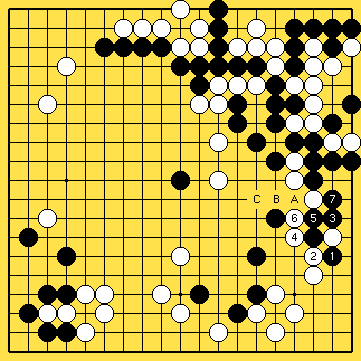
Black 1 is not a bad move in general and it is even
playable in this game. There is however, a price
black will have to pay for capturing one white stone
and ruining white's territory at the side. White can
skillfully let go of a stone in order to tie his stones
together. Here this will probably mean that the black
stones close to the center get isolated and have to
manage making life on their own.
Note that white might want to think which move to play
in answer to black 7, the solid connection at A seems
natural but a white move at B is more aggressive towards
the isolated black stones. If, after white B, black
captures the ko at A white plays the perfect extension
at C, this would be very much to white's liking.
|
Diagram 1 |
|
|
|
Fight on Your Own Turf |

There were plenty of moves black could have played in
answer to white 6 since, however, simply ignoring white
6 does not imply an unbearable loss of kinds black
played tenuki.
When looking at the amount of dead and captured white
stones there does not seem to be much what black can do
wrong here so it is not really all that interesting to
go on in detail about exactly how good or bad black's
play is.
Having said this, black of course can blunder and throw
away the game. For now his attitude of trying to keep
things simple and clear while not worrying about white
territory is very effective.
Black 11 is a key-point. Black managed by playing
lightly to break away from playing in a strictly white
sphere of influence and he skillfully involves the rest
of the board with the situation in the lower right
quadrant. After black 11 (and 7) white suddenly has come
under attack himself, again.
In the mean time, black's main goal should, of course,
be to finish this game and refrain from any rash
attacks. Attacking and threatening to kill some enemy
stones, are, however, not exactly the same thing and
here it is precisely the threat of killing which comes
in handy as a way for black to make sure his stones
around the board will settle and get strong once and for
all.
|
Game Diagram 49 |
|
|
|
Many times the ideal circumstances of killing your
opponents' stones is the "oops" situation. Not intending
to actually round the enemy stones up but not letting
them of the hook too easily either they can suddenly
die, although killing was by no means the foremost
reason for the attack in the first place, hence the
"oops".
Many a player, novices and high-dan alike, is but all
too aware of the "reverse oops effect" this often can
be observed in situations were one of the players is
dead-set on killing his opponents' stones no matter
what. If the hunt is on in this fashion the hunters'
stones can weaken and get isolated without the elephant
gun-toting maniac realizing this. Next when the
originally weak group, the prey, skillfully ensures life
by killing one or more attacking groups, the hunter goes
"oops" and usually blushes a little.
(for best effect the killing move which turns the tables
should be ideally played just when your opponent is
about to swallow a mouth full of coffee or other fluid,
spectacular fountain like show guaranteed)
Starting Something ? |
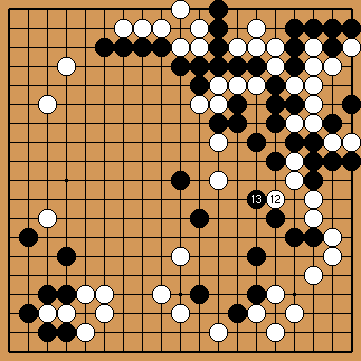
White 12 is the kind of move which could start something
going. It does protect two white stones from being
captured and it creates some cutting potential. Keep in
mind, however, that we're still talking about remote
possibilities, whether white 12 was a splendid move or
not will most likely not effect the game much. That is,
if black won't start to self-destruct.
|
Game Diagram 50 |
|
|
|
Black's Perfect Shape
|
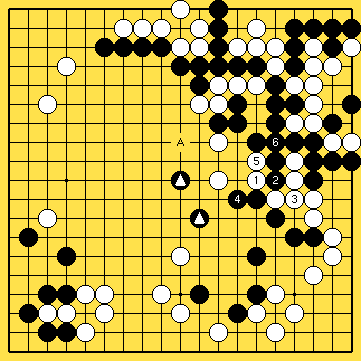
White can try to cut with 1 and see what happens. Black
4 is a very important move, if black get it in his
head to play an atari somewhere (bad idea) than white
could probably do some damage. Notice that black 4
is especially nice because it makes a good-looking
formation with the help of the marked black stones. It
almost seems impossible for white to get away, perhaps
a move like A is the best white can do but somehow it
doesn't look very convincing.
|
Diagram 2 |
|
|
|
The Last Offensive |
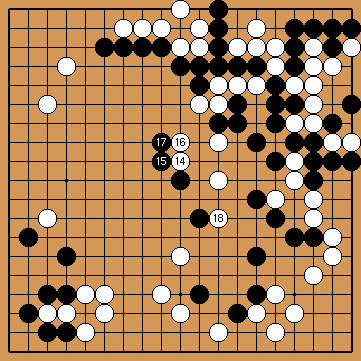
White tries to solidify his stones a bit when attaching
at 14. White 16 is also very much with that idea in
mind but after black 17 one does not really get the
feeling that white accomplished much here. White 18 is
more interesting, there still are some not 100% settled
stones in the neighborhood and although the likeness of
capturing them is at best remote white shows that he is
not ready to call it a day, not just yet.
|
Game Diagram 51 |
|
|
|
Now there seem to be a number of possible answers for
black, what would you do? (the game move is about as
vulgar a move as can get, which does not necessarily
mean it is a bad move. Can you find that move which
looks not at all elegant but not too bad either?)
Intermission
Go Seigen -the- go player of the 20th century is still
living in Japan and well protected by his manager from
rude questions and or the media in general. Thanks to an
introduction and a lot of luck I could meet the go-saint
once but was totally overwhelmed by Go's energy and
strong mental presence. For this reason, I very much
wanted (and want!) to meet him again.
What
To Ask Go Seigen
Date: 2000-12-11 02:23:58 PST
|
I'm thinking of trying to do a follow up interview with Go Seigen.
While preparing for the first interview I discovered
that 90% (or more) of the questions I was thinking
of asking were meaningless or trivial in a way. As a
matter of fact as of today I still haven't found -the-
question, worthy of asking the most famous go player in
the world.
If you have any suggestions please tell me.
|
|
Some Reactions Were:
Well, that is a good question :) what about if you asked
him, what a good question might be to ask him I mean, if
you don't know what to talk to him about then together
talk about what might be talked about :)
works with women :) :)
might work with blokes :)
Why not just ask him to review some games from the
European Fujitsu finals, especially the openings.
Perhaps he can give his opinion on European go.
The subject of go is where a professional will have
something interesting to say, something only a
professional can say.
"Do you know where I can get a burger and some fries around here?"
I'd like to know his views on rule reform, especially
free handicap placement and accurate komi. If all top
pros played with 7.5 komi for the next 100 years, would
the last ten years of results still favor White? By more
than they would favor Black if it was 6.5?
Also, in his estimation, what is the average number of
different playable moves top pros could come up with at
each stage of the game, assuming they were encouraged
to be creative? I.e., on average, how many distinct
good moves are there for Black 1, White 2, Black 3...
White 100... Black 201, etc.? At what point in the game
does he typically feel that he has only one or two
distinct playable moves to choose from at every move?
How frequently does he feel such a constraint of choices
in the opening and middle game?
I would be interested to know how he rates great
historical go players, both relative to each other and
relative to modern players. In particular does he think
one was the greatest of all (apart from him).
It would be interesting to hear his views on women
playing go, eg. why there have been (and still are)
relatively few women at the highest levels in the
go playing world; does he think this is improving;
prospects for future Honinbo + other top titles.
(Rui Naiwei studied under Go Seigen during her stay in
Japan...)
Unfortunately the follow-up interview is still not
realized and possibly never will take place. Could it be
because the perfect question has not been found yet?
When I have something more to tell you about the
Go-Genius I promise to get back to you. Just out of
sheer malice and a craving to tease you: I'm still
sitting on the literal text of the first interview, I've
only used this sparsely because there was a lot I didn't
understand completely and I needed some time to sort
things out.
Besides Go-sensei, his wife took part in the
conversation too and although maybe not on the same
go-level as the master himself, she certainly does match
Go's energy and sharp mind.
I've no idea when or/and if I ever will get around to
setting all this on paper, if not, try to obtain the
video tapes made during the interview. I promise to make
a treasure-map with an "X" on it showing the place were
I buried them just before leaving for Walhalla.
Back to the game...
Peep of the Century |

Well, if this isn't the peep of the century than I don't
know what is! It might be a reasonable move but for now
it feels fishy. Black seems to be over eager to make
white believe that if white connects solidly against
the peculiar peep he is in for a lot of trouble. This
could be true, of course, but this situation definitely
deserves some closer attention
|
Game Diagram 52 |
|
|
|
White 3 Tesuji |
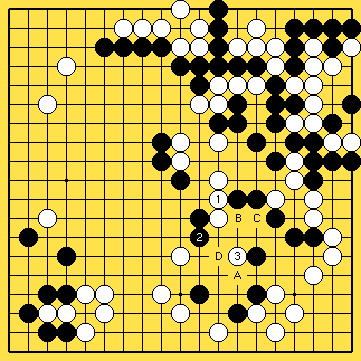
After white connects at 1 the question is how dangerous
exactly is the extension of black 2 ?
White has to watch his step as there are many wrong
moves and pitfalls (did anybody say "Indiana Jones"?)
Once white has played at the heart of the shape with 3
things will work out just fine. If black, for example,
would answer white 3 at A next white B, black C and
white D there is nothing black can do to keep white from
breaking free or capturing some black stones, play it
through and see for yourself.
|
Diagram 3 |
|
|
|
Struggle |
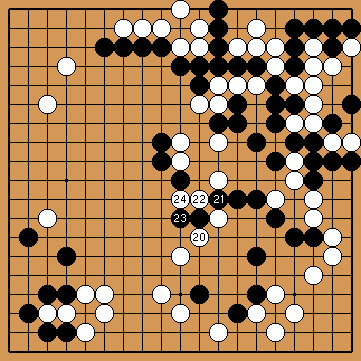
Undoubtedly white had read out the sequence shown in dia
3 but it seems white is tired of the game and looking
for a good opportunity to resign. Well, he could be
faking this state of mind and try to lure black in a
sneaky trap somewhere, couldn't he?
White 20 is questionable, that is to say, the solid
connection is best but this does not help white one iota
to get back in the game so for that matter are the game
move and the solid connection of equal value: they both
lose.
Black 21-23 are natural and should be played without
hesitation. Regardless of how many big fish you caught
already, there is always room for one more??..
White 24 does not look hopeful.
|
Game Diagram 53 |
|
|
|
Good Enough |
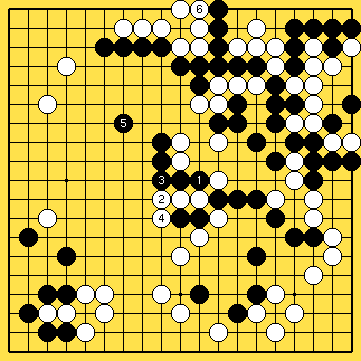
If black would want a sure win then dia 4 shown one
possible way of achieving that. You could argue that
black's play is a bit slack but undoubtedly it gives
black a solid lead and an virtually guaranteed victory.
White 4 is necessary to kill the bad aji and black 5 is
hu-ge, a splendid move to reinforce his stones while
at the same time keeping white captured at the largest
possible scale. Next white 6 would be the biggest move,
making eyes at the side.
Now it is black's turn and with 25 white stones captured
he can just shift to neutral and cast until the end of
the game.
|
Diagram 4 |
|
|
|
The End is Near |
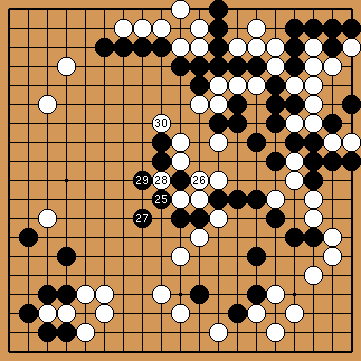
Black, again, goes for the Jackpot, a real big fish.
The focus of the game is now no longer on whether white
can capture some black stones or not. At present the
only question which is on both players mind is: "Can the
white center group survive?"
|
Game Diagram 54 |
|
|
|
Best What White Can Hope For |

Let's make one thing clear first, white is dead already
(although a few stones might be able to escape). If
black won't make any strange moves there's no way on
earth white can make two eyes.
Dia 5 gives an example where black did make a
questionable move or two. In an actual game black would
of course take the ko once first but in order to stay
on track let's assume white can and did win the ko and
black has to defend at 8. The whole sequence feels
natural but black 12 is a bad mistake, capturing two
white stones will make white 13 sente and once white
gets to play 15 black only can play the ko in order to
try and kill white. This is a success for white (if
black 12 just defend against the atari by connecting his
stones instead of capturing white 13 will not be a sente
move and white dies unconditionally)
|
Diagram 5 |
|
|
|
The Final Curtain |
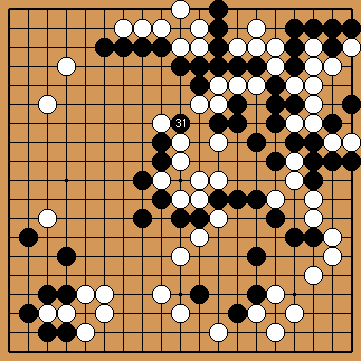
Maybe black was lazy or perhaps he just doesn't read too
well, whichever it might be instead of capturing white
whole black cut at 31. Strictly speaking this is not the
best move, but once again isn't any move which brings
you closer to victory a perfect move? And helping black
a lot it certainly does, move 31 that is. The center
white stones are captured unconditionally and that is
quite enough.
|
Game Diagram 55 |
|
|
|
You still want to know who the players were? Well, if
you came this far I guess you do:
Black: Pieter Mioch
(you didn't actually think I'd post a game of mine I lost, uh?)
White: Filip Vanderstappen, Dutch 5-dan, European rating over 2500.
[Daigo 1]
[Daigo 2]
[Daigo 3]
[Daigo 4]
[Daigo 5]
[Daigo 6]
[Daigo 7]
Copyright by
Pieter Mioch, August 2001
| |















